Was this going to be a passive system or active?
Because in an active system those responses don't say much.
Because in an active system those responses don't say much.
Please elaborate.
I would rather have the alignment mechanically right rather than immediately jump to correction.
I have made a couple of systems with BR alignments that were made to be corrected/altered but I can't see a benefit elsewhere.
I would rather have the alignment mechanically right rather than immediately jump to correction.
I have made a couple of systems with BR alignments that were made to be corrected/altered but I can't see a benefit elsewhere.
What was your alternative already? The Faital 10PR320 that is also considerable due to not having than high Mms (mid frequencies like that) is sort of a mixed bag:
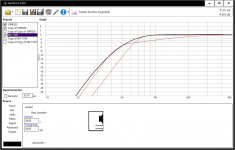
1) Beyma SM-110/N (black): 30l @ fb=45Hz : f3=60 , f6=48
2) Faital 10PR320 (red): 20l @ fb=65Hz : f3= 67, f6=60
3) Faital 10PR320 (red): 30l @ fb=45Hz : f3=88 , f6=47
And although you seem to refrain from an assisted tuning as per Keele (vented 6th-order), here is another graph showing exactly this. The reaction of the Beyma driver to additional power is better than Faital's, both drivers in 30l, fb=35Hz.
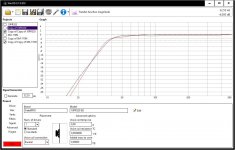
1) Beyma SM-110/N, with PEQ1 (fc=38Hz, q=2, gain=5db), PEQ2 (fc=50Hz, q=1,5, gain=3dB): f3=38Hz, f6=34Hz
2) Faital 10PR320, with PEQ1 (fc=38Hz, q=2, gain=6db), PEQ2 (fc=65Hz, q=1,5, gain=3,5dB), PEQ3 (fc=130Hz, q=1,5, gain1=dB): f3=37Hz, f6=32Hz
Considerably more extra power needed for the Faital to perform as the Beyma does when it is assisted.

1) Beyma SM-110/N (black): 30l @ fb=45Hz : f3=60 , f6=48
2) Faital 10PR320 (red): 20l @ fb=65Hz : f3= 67, f6=60
3) Faital 10PR320 (red): 30l @ fb=45Hz : f3=88 , f6=47
And although you seem to refrain from an assisted tuning as per Keele (vented 6th-order), here is another graph showing exactly this. The reaction of the Beyma driver to additional power is better than Faital's, both drivers in 30l, fb=35Hz.

1) Beyma SM-110/N, with PEQ1 (fc=38Hz, q=2, gain=5db), PEQ2 (fc=50Hz, q=1,5, gain=3dB): f3=38Hz, f6=34Hz
2) Faital 10PR320, with PEQ1 (fc=38Hz, q=2, gain=6db), PEQ2 (fc=65Hz, q=1,5, gain=3,5dB), PEQ3 (fc=130Hz, q=1,5, gain1=dB): f3=37Hz, f6=32Hz
Considerably more extra power needed for the Faital to perform as the Beyma does when it is assisted.
Please elaborate.
I would rather have the alignment mechanically right rather than immediately jump to correction.
I have made a couple of systems with BR alignments that were made to be corrected/altered but I can't see a benefit elsewhere.
I thought you also have some subwoofers as well, if I am not mistaken (could be wrong, I forgot?)
In that case, don't even bother going BR
In active systems it is very easy to tune things.
Obviously not when going to the extremes, but just a couple of dB here and there I wouldn't give up a certain driver.
Especially not when it has other advantages.
Why do you think a mechanical alignment would be beneficial?
Well, if you EQ a sealed box to the same curve you take up more amp power and xmax (compromising mid performance - IMD) and you end up with similar group delay. I can't see the point if we get a free helping hand from physics with a BR alignment.
A couple of things to reiterate - this is a two way and the subs in my original picture will not be used - also, I am getting a lot of boundary reinforcement therefore, the extended bass should should be corrected by the room to some degree.
Just because active EQ is at my disposal I don't want it to be my first port of call.
The Beyma is looking like a good option with the 40L cab as it has a nice roll off that will need to be attentuated for my room. Ergo: less cone movement.
So yeah, the Beyma and the Faital are my front runners at the moment.
A couple of things to reiterate - this is a two way and the subs in my original picture will not be used - also, I am getting a lot of boundary reinforcement therefore, the extended bass should should be corrected by the room to some degree.
Just because active EQ is at my disposal I don't want it to be my first port of call.
The Beyma is looking like a good option with the 40L cab as it has a nice roll off that will need to be attentuated for my room. Ergo: less cone movement.
So yeah, the Beyma and the Faital are my front runners at the moment.
Using a BR instead of using those extra subs is a compromise that is far more significant that a bit of EQ'ing!!!
A full-range BR is always a compromise in my book.
If you really want to go for the best possible performance, not the way to go.
btw, we are not talking about many dB's of EQ, just little bit here and there.
Nothing that will compromise mid performance or IMD.
In fact, depending on the woofer sometimes there won't be any compromise at all when you really compare apples with apples in the same system.
If you want to compare the two, one should also look at the sensitivity, distortion etc.
So saying that an EQ is by definition always a compromise is a bit of a strange statement without knowing the full context.
A full-range BR is always a compromise in my book.
If you really want to go for the best possible performance, not the way to go.
btw, we are not talking about many dB's of EQ, just little bit here and there.
Nothing that will compromise mid performance or IMD.
In fact, depending on the woofer sometimes there won't be any compromise at all when you really compare apples with apples in the same system.
If you want to compare the two, one should also look at the sensitivity, distortion etc.
So saying that an EQ is by definition always a compromise is a bit of a strange statement without knowing the full context.
Thanks for your opinion.
I didn't say EQ is always a compromise. Within the context of what I am looking to do (a 2 way vented system) I would rather use it for subtle room correction after the alignment is made to spec and use the benefits. In holistic design EQ is not a dirty word, it's a tool. Ian Malcolm on some dinosaurs - "Your scientists were so preoccupied with whether they could, they didn't stop to think if they should."
My opening post does explain most if not all of this 🙂
I didn't say EQ is always a compromise. Within the context of what I am looking to do (a 2 way vented system) I would rather use it for subtle room correction after the alignment is made to spec and use the benefits. In holistic design EQ is not a dirty word, it's a tool. Ian Malcolm on some dinosaurs - "Your scientists were so preoccupied with whether they could, they didn't stop to think if they should."
My opening post does explain most if not all of this 🙂
I am just trying to tell that EQ'ing is part of the spec of alignment. It's exactly the same thing.
Or in other words, you are making it yourself unnecessarily difficult to not see those two as one.
I don't understand why.
People (incl myself) have been using that for years in professional solutions.
It's also not really just my opinion, I am just sharing what can be found in the literature.
I do understand and respect if you want to go into a different route. I am just sharing my experience and advice.
But in the end you're the cook.
Or in other words, you are making it yourself unnecessarily difficult to not see those two as one.
I don't understand why.
People (incl myself) have been using that for years in professional solutions.
It's also not really just my opinion, I am just sharing what can be found in the literature.
I do understand and respect if you want to go into a different route. I am just sharing my experience and advice.
But in the end you're the cook.
I don't understand what you think I am making hard for myself? By proposing an extra 10l of cabinet space to get the same (arguably better) results that DSP could produce in a slightly smaller box with more watts? You're also not reading what I am saying because I agreed with you.
Please be more explicit rather than just telling me I am wrong and that your opinion is gospel. I haven't even committed to a driver...
Please be more explicit rather than just telling me I am wrong and that your opinion is gospel. I haven't even committed to a driver...
I think we are misreading each other.
What I am trying to explain, is a more general example.
To summarize;
It's better to have a woofer that has much better performance (distortion, freq resp etc etc) and maybe correct it a little, than a woofer that will fit just right in the box, but also performs a little less.
Since correcting something electrically will result in the same thing as correcting something acoustically.
They are literally interchangeable.
Obviously within limits, but a few dB is nothing to be worried about.
Another example of this, is to raise the DC (series) resistance, or changing the Qt with the Qes by adding a bucking magnet etc.
In the old(er) days we used to do this with a variable impedance amplifier;
Variable Amplifier Impedance
You do need to keep an eye on the Fs, since most speakers can behave rather unpredictable below the Fs.
What I am trying to explain, is a more general example.
To summarize;
It's better to have a woofer that has much better performance (distortion, freq resp etc etc) and maybe correct it a little, than a woofer that will fit just right in the box, but also performs a little less.
Since correcting something electrically will result in the same thing as correcting something acoustically.
They are literally interchangeable.
Obviously within limits, but a few dB is nothing to be worried about.
Another example of this, is to raise the DC (series) resistance, or changing the Qt with the Qes by adding a bucking magnet etc.
In the old(er) days we used to do this with a variable impedance amplifier;
Variable Amplifier Impedance
You do need to keep an eye on the Fs, since most speakers can behave rather unpredictable below the Fs.
The one bright spot in the above debate is that grahamgraham can build the BR alignment and block it to access the differences.
this!
and he can put 10 cans of milk inside the cabinet to see how it performs at 30l, assisted .. 😛
and he can put 10 cans of milk inside the cabinet to see how it performs at 30l, assisted .. 😛
Graham,
maybe the SICA 10 SR 2,5 CP might be an option for you, despite, or because of it's higher Mms. It was the best simulating ten-inch PA driver in a small enclosure and it does extend up to the neccessary crossover frequency rather smoothly. Sadly, SICA only provides graphs of the driver boxed-up. If there is a resonance somewhere in the band, I could not find out. I also have not found out how to judge mid range capabilities in respect to Mms, sadly. The official opinion is low Mms, but what does that mean, i.e., if a twelve-inch driver has an Mms of ~ 50g, like the Faital 12PR320, but also the smaller SICA, which is a ten-inch driver, and both have the same BL, can the ten-inch driver compete in this domain? So I do not know if Mms has to be accounted for as an absolute variable, if it is relative to other parameters and how does it "size" then, and so on. But maybe you do! Anyway, for an approach without EQ, this could be worth trying.
maybe the SICA 10 SR 2,5 CP might be an option for you, despite, or because of it's higher Mms. It was the best simulating ten-inch PA driver in a small enclosure and it does extend up to the neccessary crossover frequency rather smoothly. Sadly, SICA only provides graphs of the driver boxed-up. If there is a resonance somewhere in the band, I could not find out. I also have not found out how to judge mid range capabilities in respect to Mms, sadly. The official opinion is low Mms, but what does that mean, i.e., if a twelve-inch driver has an Mms of ~ 50g, like the Faital 12PR320, but also the smaller SICA, which is a ten-inch driver, and both have the same BL, can the ten-inch driver compete in this domain? So I do not know if Mms has to be accounted for as an absolute variable, if it is relative to other parameters and how does it "size" then, and so on. But maybe you do! Anyway, for an approach without EQ, this could be worth trying.
According to measurements on this site Countach – Donhighend Audio the break up is already at 1.5k and more dramatic, this might be a no go.
I thought you also have some subwoofers as well, if I am not mistaken (could be wrong, I forgot?)
In that case, don't even bother going BR
In active systems it is very easy to tune things.
Obviously not when going to the extremes, but just a couple of dB here and there I wouldn't give up a certain driver.
Especially not when it has other advantages.
Why do you think a mechanical alignment would be beneficial?
May I ask for probably a stupid/uneducated clarification! 🙂 (
With your post you mean that its better to calculate your cab as a closed enclosure and not some BR alinement if you are planning to go active?
(Asking for a jbl 2226H)
This kind of approach is all dependant on the desired outcome. If you want the response of a BR from a sealed cab and do it with DSP you will run out of xmax and watts fast. But if you want a smaller cab you can tease the lower response out of it without as much impact on recourses.
Yes, the usual suspects from Faital in 10" call for small volumes in BR and sealed and don´t do that much bass. A linkwitz transform ends in lots of cone movement and probably spoils the mids.
Did I mention the SPA-110PA from Monacor? That looks nicer in BR and also usable sealed with some LT. Unfortunately they don´t provide response off axis but it doesn´t seem to have nasty break-ups.
If I ever want to go 10" I might get that magazine from this project to see how it measures:
10-34 MK II
Did I mention the SPA-110PA from Monacor? That looks nicer in BR and also usable sealed with some LT. Unfortunately they don´t provide response off axis but it doesn´t seem to have nasty break-ups.
If I ever want to go 10" I might get that magazine from this project to see how it measures:
10-34 MK II
In the initial discussion of Matthias' monkey box speaker, the Fane Sovereign Pro 10-300SC was mentioned, as I had stumpled upon it right before I found that discussion, I tried it out against the direct competition. This time, fitting enclosure size and tuning to a flat response. As I remembered that you wanted to buy British, this might be your guy. It performs right in the middle between the Italian FaitalPro and the Spanish Beyma. For a flat, non-assisted response, the Beyma requires more volume, lower tuning, the Faital little volume, comparatively high tuning, and the Fane sits in-between.
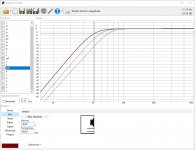
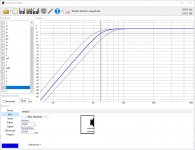
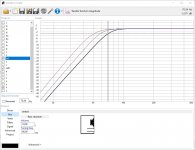



First, there are no stupid questions! 😉 🙂May I ask for probably a stupid/uneducated clarification! 🙂 (
With your post you mean that its better to calculate your cab as a closed enclosure and not some BR alinement if you are planning to go active?
(Asking for a jbl 2226H)
But no, that is not what I meant with my post. 🙂
What I meant, is that BR alignments can be corrected (to some extend) in an active system.
So don't stare blindly to just acoustic responses and alignments.
As usual, a lot depends on the use case.
And what variables or compromises of the whole system are important.
Closed systems are just a bit more predictable.
What are you planning to do with that jbl 2226H ?
- Home
- Loudspeakers
- Multi-Way
- 10" + CD/Horn 2-Way